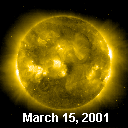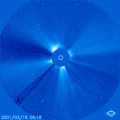|   SPACE WEATHER SPACE WEATHER
Current
Conditions
Solar Wind
velocity: 307.8 km/s
density:2.6 protons/cm3
explanation | more data
Updated: Today at 2153 UT
X-ray Solar Flares
6-hr max: C3 1720 UT Mar17
24-hr: C3 1720 UT Mar17
explanation | more data
Updated: Today at 2250 UT
Daily Sun: 16 Mar '01 
Sunspot group 9373, which was in decay earlier this week, has now developed a complex beta-gamma magnetic field that harbors energy for M-class solar flares.
Sunspot Number: 86
More about sunspots
Updated: 16 Mar 2001
Radio Meteor Rate
24 hr max: 28 per hr
Listen to the Meteor Radar!
Updated: 16 Mar 2001 Interplanetary Mag. Field
Btotal: 5.7 nT
Bz: 2.5 nT north
explanation | more data
Updated: Today at 2154 UT Coronal Holes:

There are no substantial coronal holes visible in this ultraviolet image of the Sun. Image credit: SOHO Extreme UV Telescope.
More about coronal holes
 SPACE WEATHER SPACE WEATHER
NOAA
Forecasts
Solar Flares: Probabilities for a medium-sized (M-class) or a major (X-class) solar flare during the next 24/48 hours are tabulated below.
Updated at 2001 Mar 17 2200 UT
| FLARE | 24 hr | 48 hr | | CLASS M | 30 % | 30 % | | CLASS X | 01 % | 01 % |
Geomagnetic Storms: Probabilities for significant disturbances in Earth's magnetic field are given for three activity levels: active, minor storm, severe storm
Updated at 2001 Mar 17 2200 UT Mid-latitudes | 24 hr | 48 hr | | ACTIVE | 10 % | 15 % | | MINOR | 05 % | 10 % | | SEVERE | 01 % | 02 % |
High latitudes | 24 hr | 48 hr | | ACTIVE | 15 % | 25 % | | MINOR | 05 % | 10 % | | SEVERE | 01 % | 05 % |
| What's Up in Space -- 17 Mar 2001
Subscribe to Space Weather News!  SOLAR ACTIVITY: Active region 9373, a sprawling sunspot group near the center of the Sun's disk, is growing again and poses a threat for eruptions. It has a tangled beta-gamma magnetic field that could harbor energy for M-class solar flares. Right: SOHO coronagraphs recorded this partial-halo coronal mass ejection (CME) on March 16th shortly after a solar filament collapsed. The CME does not appear to be heading for Earth. SOLAR ACTIVITY: Active region 9373, a sprawling sunspot group near the center of the Sun's disk, is growing again and poses a threat for eruptions. It has a tangled beta-gamma magnetic field that could harbor energy for M-class solar flares. Right: SOHO coronagraphs recorded this partial-halo coronal mass ejection (CME) on March 16th shortly after a solar filament collapsed. The CME does not appear to be heading for Earth.
HERE COMES MIR: On March 22, 2001, the Russian Space Agency will ignite the engines of a Progress rocket attached to Mir and send the 135-ton space station to a watery grave in the remote south Pacific. The space station will join a surprising parade of Mir-sized objects that hit Earth every year. [Full Story] WEB LINKS: NOAA FORECAST | GLOSSARY | SPACE WEATHER TUTORIAL | LESSON PLANS | BECOME A SUBSCRIBER |  On March 3rd MIT's LINEAR program discovered a new near-Earth asteroid, 2001 EC. The kilometer-wide space rock zoomed past Earth on Feb. 27th just four times farther away than the Moon and brightened to 11th magnitude at closest approach. [3D orbit][ephemeris] 
- TOTAL LUNAR ECLIPSE: On Jan. 9, 2001, the full Moon glided through Earth's copper-colored shadow. [gallery]
- CHRISTMAS ECLIPSE: Sky watchers across North America enjoyed a partial solar eclipse on Christmas Day 2000 [gallery]
- LEONIDS 2000: Observers around the globe enjoyed three predicted episodes of shooting stars. [gallery]
 Feb. 21, 2001: Nature's Tiniest Space Junk -- Using an experimental radar at the Marshall Space Flight Center, scientists are monitoring tiny but hazardous meteoroids that swarm around our planet. Feb. 15, 2001: The Sun Does a Flip -- NASA scientists who monitor the Sun say our star's enormous magnetic field is reversing -- a sure sign that solar maximum is here. Jan. 25, 2001: Earth's Invisible Magnetic Tail -- NASA's IMAGE spacecraft, the first to enjoy a global view of the magnetosphere, spotted a curious plasma tail pointing from Earth toward the Sun. Jan. 4, 2001: Earth at Perihelion -- On January 4, 2001, our planet made its annual closest approach to the Sun. Dec. 29, 2000: Millennium Meteors -- North Americans will have a front-row seat for a brief but powerful meteor shower on January 3, 2001. Dec. 28, 2000: Galileo Looks for Auroras on Ganymede -- NASA's durable Galileo spacecraft flew above the solar system's largest moon this morning in search of extraterrestrial "Northern Lights" Dec. 22, 2000: Watching the Angry Sun -- Solar physicists are enjoying their best-ever look at a Solar Maximum thanks to NOAA and NASA satellites. MORE SPACE WEATHER HEADLINES |



